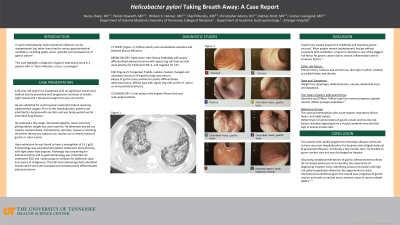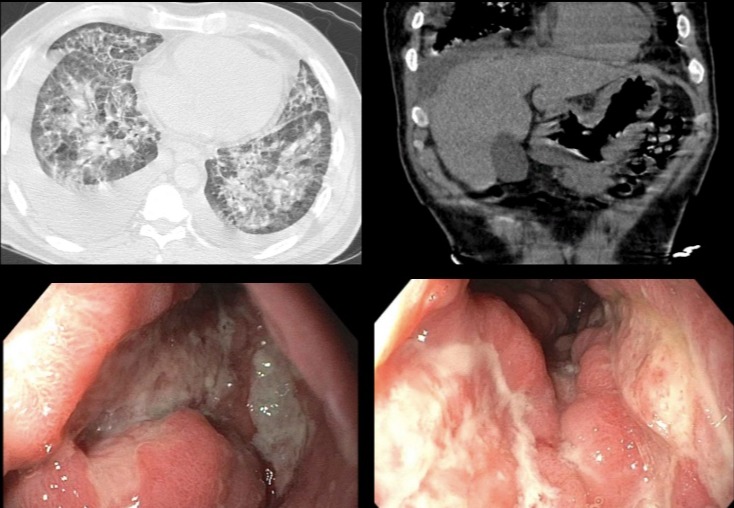Sunday Poster Session
Category: Stomach
P1368 - Helicobacter pylori Taking Breath Away: A Case Report
Sunday, October 22, 2023
3:30 PM - 7:00 PM PT
Location: Exhibit Hall

Has Audio
- PH
Patrick Howarth, MD
University of Tennessee HSC College of Medicine Chattanooga
Chattanooga, TN
Presenting Author(s)
Patrick Howarth, MD, William K. Oelsner, MD, Sharif Murphy, MD, Christopher Adams, DO, MS, BS, Nathan Brott, MD, Connor Lovingood, MD, Nancy Jhanji, DO
University of Tennessee HSC College of Medicine Chattanooga, Chattanooga, TN
Introduction: H. pylori (Helicobacter pylori) is a bacteria that can infect the stomach lining. Most H. pylori infections can be asymptomatic but other times lead to various gastrointestinal conditions, including peptic ulcers and gastritis. Sometimes, long-term infection increases risk of developing cancer, particularly gastric adenocarcinoma.
Case Description/Methods: A 43 y.o. male with no significant past medical history presented with progressive shortness of breath, night sweats and 50 pound weight loss over 6 months. He was admitted for acute hypoxic respiratory failure. He immigrated from Guatemala to the United States over a year ago. He endorsed a dry cough, decreased appetite with weight loss and insomnia. He denied melena, hematochezia, hematemesis, diarrhea, nausea or vomiting. His diet mainly consisted of animal protein with very little vegetables and processed foods. He denied any tobacco, alcohol use or family history of gastric or colon cancer. CT chest showed diffuse patchy and consolidative opacities and pleural effusions. This patient’s hospital course was complicated by pneumothorax requiring chest tube placement. He underwent bronchoscopy with right lower lobe biopsy showing poorly differentiated adenocarcinoma with signet ring cell features that were positive for CK20 and CDX–2, and negative for CK7.
Based on biopsy findings gastroenterology was consulted. Colonoscopy showed a 5 mm polyp in the hepatic flexure that was semi-pedunculated. EGD showed congested, friable, nodular, texture changed and ulcerated mucosa in the gastric body and antrum. Biopsies from gastric mass were positive for poorly differentiated adenocarcinoma, diffuse type with signet ring cells and for H. pylori on immunohistochemistry.
Discussion: Common risk factors for gastric adenocarcinoma include H pylori, age, male sex, family history, tobacco and alcohol use, diet high in salted, smoked, or pickled foods, and obesity. Common presenting symptoms are nonspecific weight loss, dysphagia, abdominal pain, nausea, abdominal mass and dyspepsia. This case is particularly interesting as he was a young man with presenting symptoms of weight loss, fevers, and night sweats. He had no family history of gastric cancer and with only risk factors being emigration from H pylori endemic area and high animal protein diet. While the patient's initial CT showed mild gastric wall thickening, prior to lung biopsy there were no indications to complete EGD or colonoscopy.

Disclosures:
Patrick Howarth, MD, William K. Oelsner, MD, Sharif Murphy, MD, Christopher Adams, DO, MS, BS, Nathan Brott, MD, Connor Lovingood, MD, Nancy Jhanji, DO. P1368 - Helicobacter pylori Taking Breath Away: A Case Report, ACG 2023 Annual Scientific Meeting Abstracts. Vancouver, BC, Canada: American College of Gastroenterology.
University of Tennessee HSC College of Medicine Chattanooga, Chattanooga, TN
Introduction: H. pylori (Helicobacter pylori) is a bacteria that can infect the stomach lining. Most H. pylori infections can be asymptomatic but other times lead to various gastrointestinal conditions, including peptic ulcers and gastritis. Sometimes, long-term infection increases risk of developing cancer, particularly gastric adenocarcinoma.
Case Description/Methods: A 43 y.o. male with no significant past medical history presented with progressive shortness of breath, night sweats and 50 pound weight loss over 6 months. He was admitted for acute hypoxic respiratory failure. He immigrated from Guatemala to the United States over a year ago. He endorsed a dry cough, decreased appetite with weight loss and insomnia. He denied melena, hematochezia, hematemesis, diarrhea, nausea or vomiting. His diet mainly consisted of animal protein with very little vegetables and processed foods. He denied any tobacco, alcohol use or family history of gastric or colon cancer. CT chest showed diffuse patchy and consolidative opacities and pleural effusions. This patient’s hospital course was complicated by pneumothorax requiring chest tube placement. He underwent bronchoscopy with right lower lobe biopsy showing poorly differentiated adenocarcinoma with signet ring cell features that were positive for CK20 and CDX–2, and negative for CK7.
Based on biopsy findings gastroenterology was consulted. Colonoscopy showed a 5 mm polyp in the hepatic flexure that was semi-pedunculated. EGD showed congested, friable, nodular, texture changed and ulcerated mucosa in the gastric body and antrum. Biopsies from gastric mass were positive for poorly differentiated adenocarcinoma, diffuse type with signet ring cells and for H. pylori on immunohistochemistry.
Discussion: Common risk factors for gastric adenocarcinoma include H pylori, age, male sex, family history, tobacco and alcohol use, diet high in salted, smoked, or pickled foods, and obesity. Common presenting symptoms are nonspecific weight loss, dysphagia, abdominal pain, nausea, abdominal mass and dyspepsia. This case is particularly interesting as he was a young man with presenting symptoms of weight loss, fevers, and night sweats. He had no family history of gastric cancer and with only risk factors being emigration from H pylori endemic area and high animal protein diet. While the patient's initial CT showed mild gastric wall thickening, prior to lung biopsy there were no indications to complete EGD or colonoscopy.

Figure: CT lungs demonstrate diffuse patchy and interstitial opacities.
CT stomach demonstrate gastric wall thickening
EGD showed congested, friable, nodular, texture changed and ulcerated mucosa in the gastric body and antrum.
CT stomach demonstrate gastric wall thickening
EGD showed congested, friable, nodular, texture changed and ulcerated mucosa in the gastric body and antrum.
Disclosures:
Patrick Howarth indicated no relevant financial relationships.
William Oelsner indicated no relevant financial relationships.
Sharif Murphy indicated no relevant financial relationships.
Christopher Adams indicated no relevant financial relationships.
Nathan Brott indicated no relevant financial relationships.
Connor Lovingood indicated no relevant financial relationships.
Nancy Jhanji indicated no relevant financial relationships.
Patrick Howarth, MD, William K. Oelsner, MD, Sharif Murphy, MD, Christopher Adams, DO, MS, BS, Nathan Brott, MD, Connor Lovingood, MD, Nancy Jhanji, DO. P1368 - Helicobacter pylori Taking Breath Away: A Case Report, ACG 2023 Annual Scientific Meeting Abstracts. Vancouver, BC, Canada: American College of Gastroenterology.
